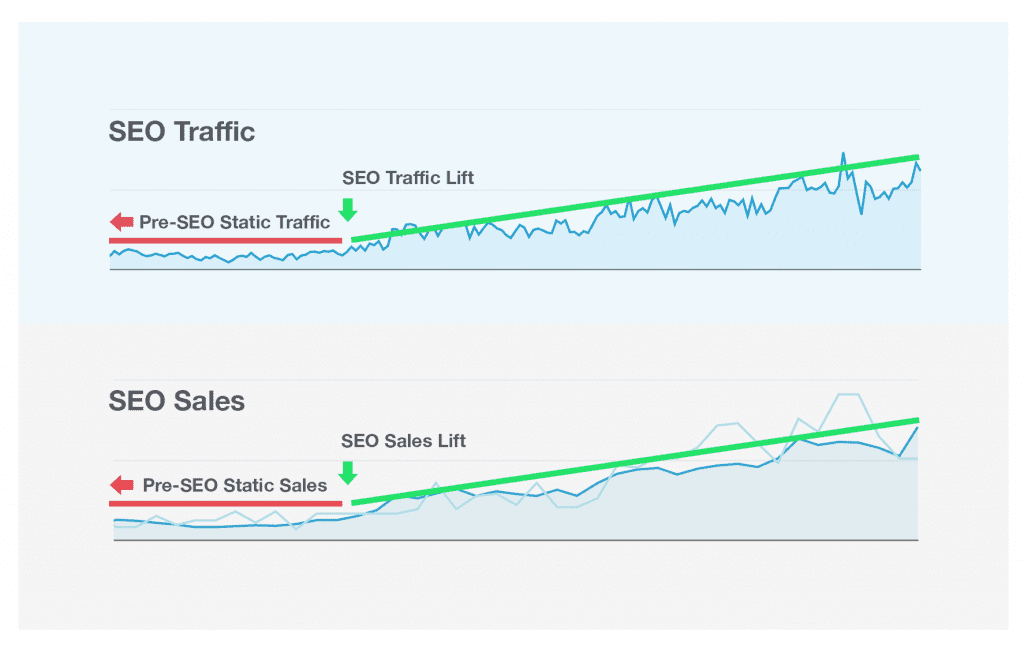Search engine optimization (SEO) is changing fast. It used to be that you could use keyword stuffing and other such techniques to boost your rankings. No longer. Google and other search engines are committed to rewarding quality content that clearly and precisely answers a browser’s question. So our SaaS company SendOwl decided to focus our SEO efforts on creating quality SEO-focused content. And it worked! Six months on our signups from SEO are at 40%.
Quick and dirty traction test
There are lots of different ways you can grow your business and it’s important to find out what works for you. Although we suspected SEO might work well for us, we weren’t going to invest 6 months of our time in an SEO strategy unless we had proof that it would work.
So, first off we ‘tested’ SEO by creating three SEO-focused blog posts and by improving internal links for other blog posts with SEO value. Immediately, we saw movement in our general rankings as well as for those two blog posts. One of those posts targeting the term jumped from ranking 25 > 6.
So, we felt we had enough reason to begin a sustained effort to boost our SEO.
Keyword research
We then chose 20 keywords that had at least 500 searches per month and were directly relevant to our business using Google Keyword Planner. Some of these were highly competitive; others less so.
SendOwl makes it easy for you to sell digital products direct to your audience from your blog, social media or anywhere you can paste a link. So our keywords included such terms as digital delivery, sell downloads and PDF stamping (if you sell eBooks then PDF stamping makes the process more secure).
Even with the science of data, there’s still some art involved. We knew there wasn’t any point choosing terms with 10,000 searches per month if they weren’t directly relevant to our business. Some of our search terms are actually quite low volume (around 500 searches per month) but highly targeted.
What gets measured gets managed
After doing keyword research, we looked around for a service that would allow us to easily monitor our progress in terms of our individual rankings for keywords and our overall ranking as well. We decided Positionly (now Unamo) offered the best user experience.
However, rankings can be a bit of a vanity metric by themselves, so we also collect data every month on the number of sign-ups to our free trial from SEO (by setting goals in Google Analytics ). This way we could keep track of how well our SEO activities were translating into sales.
Getting the basics rights
We made some basic changes to our overall website to make sure it was SEO-optimized. These included:
- Making sure that our HTML is well structured by running it through a validation tool
- Edge cache any asset files (Javascript, CSS, images) so the page loads as fast as possible
- Moved the blog from blog.sendowl.com to sendowl.com/blog to improve rankings for terms we ended up targeting with a blog post
We’d also suggest running your site through Google’s PageSpeed and making any suggested changes.
Creating an actionable SEO strategy
After looking at our 20 keywords, we made a list:
- Keywords that needed a new landing page
- Keywords that needed a new blog post
- Keywords that needed an existing landing page or blog post editing
- Blog posts that existed but Google didn’t know about, so we created some internal links
We discussed this as a team and came up with a ‘to-do’ list that we put on our content Trello board. First off, we went for some of the easy wins: the edits and the internal links. Then, we moved on to creating landing pages and blogs.
Quality first
Landing pages
Although our landing pages were going to be SEO optimized, they would be useless unless they converted real people. So, we made sure that each one clearly answered the needs of our target customers. Our landing page for the term ‘sell digital magazines’ shows how you can specifically sell magazines individually, as a subscription, or as a bundle using SendOwl. That’s important information for magazine publishers.
We also experimented with different landing page formats, so we could see whether a specific approach converted best. At SendOwl we have an in-house development team, so we’d prototype the pages in UXPin, then share and tweak until they were finished. At this prototype stage, it’s easy to make changes. Then our development team would build them.
Blog posts
It would be easy to write mediocre blog posts based on certain keywords to try and gain an SEO advantage. However, what’s the point? If you get people to a useless page they’ll be left with a very poor impression of your business. And Google is much smarter than you think! So even though we were writing blog posts with SEO as our main goal, we made sure they were genuinely useful as well as ‘evergreen’, which means that they will continue to be a valuable resource for some time to come.
Our SEO blog post on How to sell online memberships/subscriptions contains these useful sections:
- Advantages of selling memberships/subscriptions rather than one-off digital products
- What you can sell through a membership/subscription, including 4 case studies
- How you can sell subscriptions/memberships
- How you can optimize initial conversions
- How you can increase customer’s lifetime value & retention
Creating quality content takes time (and money), but we already knew from our website that quality content converts. Our website has a 6-10% conversion rate, which is impressive for e-commerce.
Initial results
After implementing only about 50% of our to-do list, we saw our overall SEO ranking nearly double in the first few months.

Sales and traffic have skyrocketed since implementing our SEO strategy.
Our hike in rankings was also beginning to translate into a very nice bump in SEO sales. SEO traffic on average was spending around 8 mins looking around 7-8 pages on our website, which showed an encouraging level of engagement.
This was good news because it showed that our SEO strategy wasn’t just bringing in more traffic, but that it was bringing in the right kind of traffic.
Optimization
After implementing stage 1 of our SEO strategy, we were already seeing some good results.
However, we knew we could make further improvements. So, stage 2 of our SEO strategy, still ongoing, is optimization. This means:
- Analyzing our best performing SEO pages and learning what makes them so effective
- Comparing and contrasting the performance of landing pages v blog posts
- A/B testing certain landing pages
We’re already seeing a positive improvement in terms of sales. We’re already seeing 40% of our signups coming from SEO. And we hope to see even more impressive results in the next 6 months.
Learnings
- Quality content matters for search engines and real people!
- Make sure you attract the right kind of SEO traffic – the type that converts
- Do a traction test first so you can make sure SEO is the right growth strategy for you
 About the Author
About the Author
Hannah Adcock is a content strategist at SendOwl. SendOwl makes it easy for you to sell digital products, memberships and subscriptions direct from your website, blog or anywhere you can paste a link.

